New York 2140
Air Date: Week of June 30, 2017
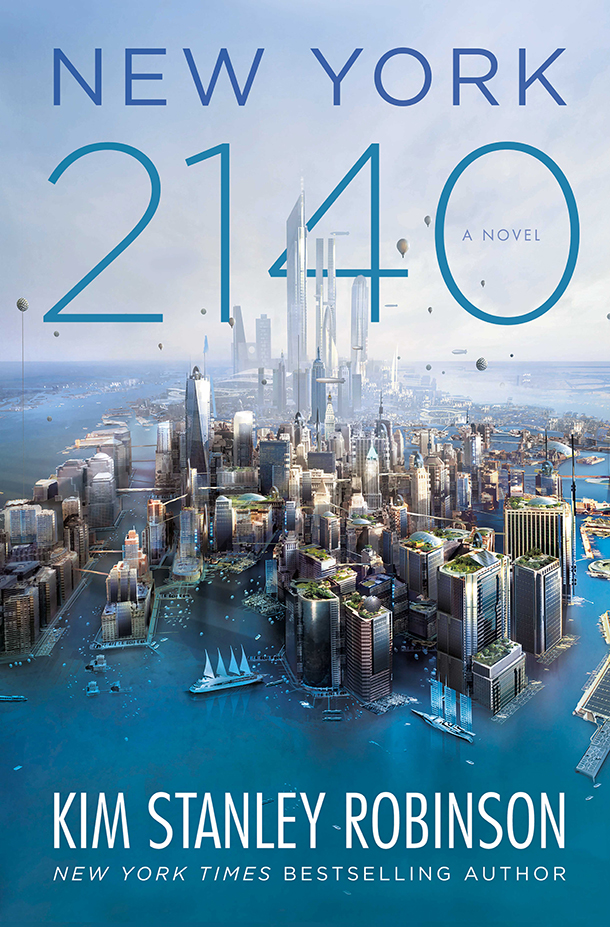
In New York 2140, author Kim Stanley Robinson envisions that sea levels have risen 50 feet, but New York is still a vibrant financial and cultural capital. (Photo: courtesy of ŒEllen B. Wright)
Melting ice sheets, and wild storms have added 50 feet to sea level and submerged coastal areas in award winning science fiction writer Kim Stanley Robinson’s latest novel, New York 2140. Yet the city is still a vibrant hub of global capital, with express boats zooming up the avenues and sky bridges linking the skyscrapers that still stand. Living on Earth’s Helen Palmer and the author discuss his twenty-second century vision and how the disaster of a “50 Katrina” hurricane hitting the Big Apple upends the economic order and creates a more equitable, environmentally aware society.
Transcript
ROBINSON: In my novel, New York 2140, I postulate a fairly rapid and severe sea level rise in the next 120 years, and I postulated that the big slides in Antarctica would come in pulses so that for ten years there’d be very rapid rise and then for 30 years not much at all and then a second pulse comes that’s even worse than the first as things get hotter and wetter.
CURWOOD: Kim Stanley Robinson has won the Hugo, Nebula and World Fantasy Awards, and many of his science fiction books, such as the Mars Trilogy, deal with ecological themes. Kim Stanley Robinson spoke with Living on Earth’s Helen Palmer.
PALMER: Kim Stanley Robinson, please could you read for me from page 139, begins with the words "first pulse".
ROBINSON: Well, sure. The first pulse was a profound shock, as how could it not be, raising sea level by 10 feet in 10 years. That was already enough to disrupt coastlines everywhere, also to grossly inconvenience all the major shipping ports around the world and shipping is trade. Those containers and their millions had been circulating by way of diesel burning ships and trucks, moving around all the stuff people wanted, produced on one continent and consumed on another following the highest rate of return, which is the only rule that people observed at that time. So, that very disregard for the consequences of their carbon burn had unleashed the ice that caused the rise in sea level and wrecked the global distribution system and caused a depression that was even more damaging to the people of that generation, then the accompanying refugee crisis which using the unit popular at the time was rated at 50 Katrinas. So, yes, the first pulse was a first-order catastrophe and it got people's attention and changes were made. Sure, people stopped burning carbon much faster than they thought they could before the first pulse. Too late, of course. The global warming initiated before the first pulse was baked in by then and could not be stopped by anything the post-pulse people could do.
PALMER: Stan, it's a fairly grim vision of the drowned world humanity’s managed to create and could well be heading for. But, you paint a picture of a remarkably resilient New York City. How do you see people living in 2140?
ROBINSON: Well, it takes a novel to describe but in brief, catastrophes will be bad. They will disrupt lives around the world at the coastlines, and the coastlines are about where a fifth of humanity lives, but it's also where trade happens, as I pointed out in that passage, and the coastlines are just crucial to human civilization. But what my novel describes is the aftermath of that disruption, so it's a fine line I have to tread because I don't want to downplay the level of the disaster which will be world historical importance.
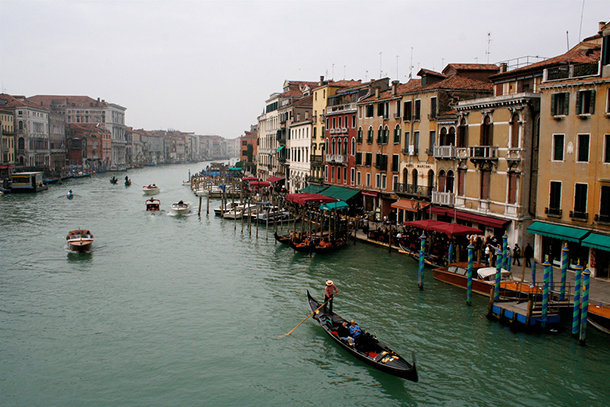
Kim Stanley Robinson’s fictional futuristic New York is like a “Super Venice” in which people get around by zooming up and down canals in boats. (Photo: John Anthony, Flickr CC BY-NC 2.0)
But afterwards, people are still going to be alive, there's going to be a lot of infrastructure that, even at the coastlines, although damaged, will still be there and people still love New York and there will still be young people who want to live their lives who are assuming this is the natural state of the world. So, my book is a comedy of coping, is really what it comes down to, describes the situation about 50 years after. What I want to do is try to attack the apocalyptic imagination; that when we cause climate change, it will simply be the end times and there will be zombies running on the streets that you'll have to shoot with machine guns. In a way that's too easy and it's also wrong.
PALMER: But I'm particularly entertained by the kind of scientific advances you see happening to make life in New York possible. I mean, for instance, the ability to live in these skyscrapers which for some reason have not collapsed due to new forms of cladding and new forms of waterproofing.
ROBINSON: Well, a lot of the skyscrapers in New York City and presumably around the world, but in Manhattan for sure, are footed in bedrock and they are concrete and steel and although living in sea water would be bad for them, it wouldn't be fatal for them. And then you’d have to start retrofitting. I do have some kind of near-future waterproofing method and some things in material science that we're right on the edge of already, graphenated composites and the like, that help them a lot in making this readjustment to becoming a super Venice.
PALMER: Well, in fact, you envision that, that the people are getting around by zooming up-and-down on what were the streets and the avenues now in their little boats because obviously the subway no longer works.
ROBINSON: That's right. There's Vaporettos as in Venice, big bus boats, ferries that move on a regular schedule through the canals. People get around also on sky bridges made of graphenated composites that link up above the sea levels. There's also the problems of the intertidal because Venice, New York Harbor has a tide that is 10 vertical feet from high tide to low tide and that is actually several blocks of midtown Manhattan that would be sloshing around and underwater at high tide but exposed at low tide, actually much more difficult to cope with than being underwater all the time. So, I tried to play the science fiction game which is you postulate one big change and then you try to play with the secondary and tertiary developments that would derive from that first big change.
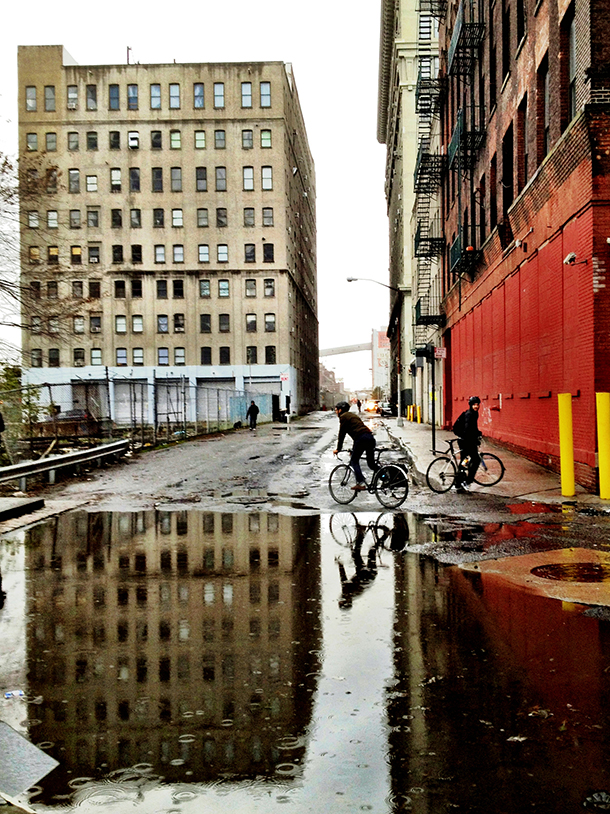
Storm surges in New York currently result in temporary rises in sea level that are nevertheless devastating, especially during severe storms like Hurricane Sandy, which soaked the city in 2012. (Photo: Erin Johnson, Flickr CC BY-NC 2.0)
PALMER: You must have done a huge amount of research to work out what would be underwater, what would be sometimes underwater, and what would be still high and dry land.
ROBINSON: Yes, that was a lot fun. I got the US Geological Survey topographical maps that overlay the contour intervals of the heights of the city area and then I visited New York with a tourist map version of that map in hand so that I could wander especially the intertidal and try to imagine what it would look like and then downtown from say the Empire State building down to the Battery would be underwater all the time. From about the Empire State building up to Central Park, or a little short of it would be the intertidal zone. That's a pretty big stretch of real estate that would be in the intertidal and what's interesting is that property law follows Roman law and nobody can own the intertidal in Roman law, and Western civilization has tended to follow that, and so it's a little bit funny in property terms, real estate, finance and financial derivatives and betting on sea level rise and betting on whether property values will go up or down.
PALMER: Well, yes, you imagine the power of the banks and hedge funds and international capital are still functioning. That was surprising to me because I thought, “Oh gosh, that system would have to collapse,” but you obviously suggest that no it wouldn't.
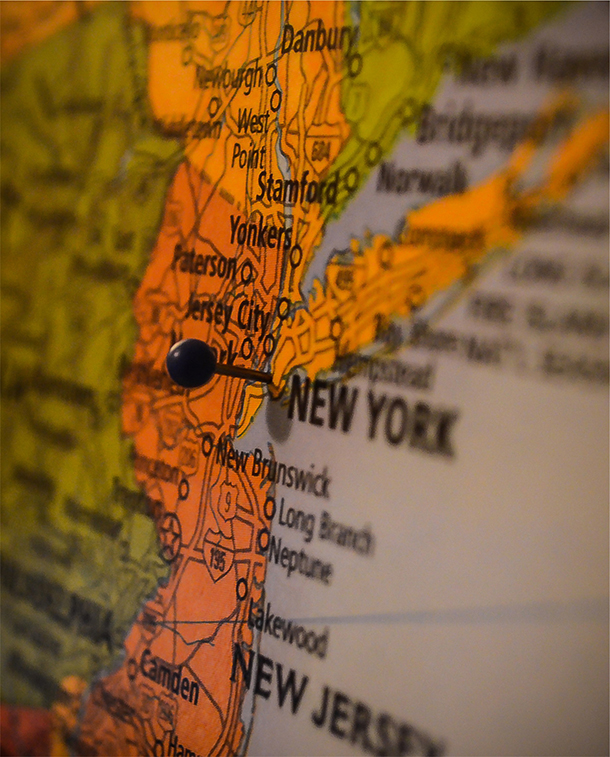
Storm surges in New York currently result in temporary rises in sea level that are nevertheless devastating, especially during severe storms like Hurricane Sandy, which soaked the city in 2012. (Photo: Erin Johnson, Flickr CC BY-NC 2.0)
ROBINSON: Well, it's a bit of a game I'm playing there were I want this novel to also examine the way that we use finance now and for sure finance preys on uses catastrophes to increase its leverage and to make profit. So, capital wants to be spent and so accumulated capital is not good and infrastructure and new infrastructure actually represents an opportunity rather than a catastrophy, or both at once.
PALMER: I like the fact that you posit this group of, what I would call “idealistic realists” who believe that there might be a different way of ordering society, a better way, and they are in basically the householders' union. Tell me about the householders' union.
ROBINSON: Sure, and this is an idea out of the some economists that I know who are basically doing political economy and they are pointing out that the way that people have power as against the oligarchies of big money are by way of unions, but the unions have been destroyed and there aren't that many plumbers in the plumbers' union. There's only so many teachers or truckers. The unions that still survive are fractionated amongst their interest groups of occupations, but everybody's a householder one way or another unless you're a homeless person and that's a different story but everybody either owns and pays mortgages or else they rent, so they all can be in a householders union and rents and mortgages are the ways in which banks keep their liquidity flowing. So these political economists are suggesting that people could engineer a crash any time they want to by withholding payments and doing a householder union fiscal noncompliance strike and then the banks would crash, they would run to the governments, and a plan would have to be in place to nationalize the banks. So, this is a relatively conservative and legal form of revolution in which you consider the governments to be your friends. The nation-state governments are the people's companies, so to speak, or the place where you believe are still of the people, by the people and for the people.
PALMER: Well, any piece of science fiction or maybe dystopia/utopia is a reflection of the world we actually live in. You've obviously reflected the world of inequality of the society that we've created in a very, I would say, creative way, in that you've envisioned a way that this inequality of our world could be repurposed. In that way, do you see it is utopian?
ROBINSON: Yes, I do and I would like to make sure that people understand utopia to mean a vision of a positive future history that's dynamic and changing, rather than a perfect end state, a society that doesn't have to change because everything is right, because utopian does mean pie-in-the-sky, never going to happen why would you suggest it, and since I've been doing it my whole career, I have to defend the other definition which is it's just trying to describe positive futures that we can then attempt to enact or ponder.

The Met building, towering over author Kim Stanley Robinson in this photo, is a hub for many of the characters in the novel. In this post-flood New York, buildings are like their own city states, housing hundreds of residents. (Photo: courtesy of ŒEllen B. Wright)
PALMER: Well, in fact, you posit this coming in the wake of a very bad hurricane that hits New York, Hurricane Fyodor. Describe to me what happens there and how that actually...what the fallout of Hurricane Fyodor is fact that triggers this turnaround for society.
ROBINSON: The New York estuary is weird and there have been hurricanes that have hit it in the past. They thrust an enormous lot of water into the bite of New York which is where Long Island meets New Jersey and what you've got is a situation where a storm surge be quite remarkable. The unnamed hurricane of 1893 had a storm surge of 30 feet and recently Hurricane Sandy, I've heard had a storm surge or something like 12 feet or 18 feet, so briefly you get sea level rise. So these aren't just waves. These are a rise in sea level that are temporary but devastating, and if you already have 50 feet of sea level rise as your norm, as your base normality, then a big hurricane and one of the things that people are talking about is superstorms coming out of climate change. A big hurricane hitting New York solid like Hurricane Sandy did would have the potential for a quite amazing storm surge and a lot of damage.
And then following that, then the people are saying, “Look, half of the apartments in New York are owned by millionaires from abroad and billionaires from abroad who are using them as safety deposit boxes for the safest way to store capital, and they can also visit the big city for a week every year and party,” but this is already true and what is interesting is I have my people demanding that these apartments be open up for the refugees to the hurricane or one of my more idealistic local politicians. Well, Jeremy Corbyn just did the very same thing in London after that apartment tower caught fire and made the same demand because London is in the same situation as New York as having a ton of great apartments that are there empty all the time because international financial oligarchs have enough money that they want to bank it by having an empty apartment in these great cities.
PALMER: Well, you have created a colorful cast of characters that inhabit the Met building. I mean, it's interesting you seem to imagine that in this post-pulse New York, there will be a shortage of living accommodation and in fact it's kind of like Russia after the revolution when suddenly these great buildings are taken over for a reasonable amount of money as opposed to just for a very few people.

New York 2140 critically evaluates the way the world uses finance currently. (Photo: CommScope, Flick CC BY-NC-ND 2.0)
ROBINSON: Well, thank you, and I'm glad that you mention that because I did take a Soviet model especially during World War II where they just jammed people in and really it was a matter of cooperate or die, and living became communal in a way that is sometimes regarded as an imposition, but other times is regarded as a liberation from nuclear family isolation and alienation, and then you might have a different kind of culture, more communal, more like Mondragon’s Spain, and the idea would be that hegemony and the notion that we need to follow the economic capitalist model they’re in right now, that would be shattered by the flood and I'm imagining every building would be almost a city-state of its own, and at the same time that you might still have the state and the federal governments overseeing things in different ways.
PALMER: One interesting thread in your book is this air ship, the Assisted Migration actually takes endangered animals from one place and relocates them somewhere more appropriate for them. Talk to me about the Assisted Migration.
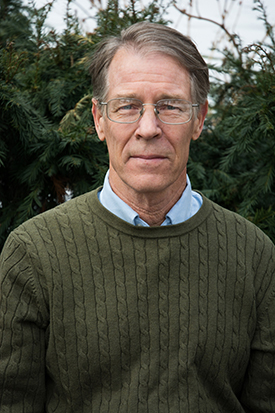
Kim Stanley Robinson has won the Hugo, Nebula and World Fantasy awards. Many of his novels deal with questions of ecological sustainability. (Photo: courtesy of ŒEllen B. Wright)
ROBINSON: Assisted migration is an idea out of population biology right now because climate change is going to create an extinction situation for many species and they're all important for the biosphere to be healthy as a whole. But there's something serious going on here, that we need habitat corridors, that wildlife needs to be able to freely move and mostly latitudinally to get to the areas where they can survive when climate change hammers their home biome. So, they're talking about, could we move like reseeding palm trees a little bit further north in Florida, do we have the power to this, do we have the right to do this and what would be the ramifications and effects of it? It's a really interesting and labor intensive project, so this notion that jobs are going to go away and that robots are going to take over everything and humans will have nothing to do is a ridiculous misunderstanding of the situation because landscape restoration’s labor intensive and so is taking care of young people and old people. It's a misreading of the opportunity that I find a little painful as you can probably tell.
PALMER: What role do you see fiction having in the future when we indeed have so many problems that really do need to be overcome?
ROBINSON: Well, I love fiction and it's really my religion. It's my way that I make meaning out of the world and I think that's what it's for. It tries to tell the stories give the big picture of what things mean because science is great as it is in explaining of how the world works. It is not in the business of saying what human life means. That just isn't what it's about. What science fiction is saying is, “Well this could happen, it would be interesting if it did, and let's put you there for a few hours whilst you're reading it,” and then when you come back home to this world, you can think, wow, what can we do to get to that positive future or what can we do to avoid that negative future.
CURWOOD: Kim Stanley Robinson’s book is New York 2140. He spoke with Living on Earth’s Helen Palmer.
Links
New York 2140 by Kim Stanley Robinson
The Guardian: Review of New York 2140: “An urgent vision of the future”
The New Yorker: “Kim Stanley Robinson’s Latest Novel Imagines Life In An Underwater New York”
Living on Earth wants to hear from you!
Living on Earth
62 Calef Highway, Suite 212
Lee, NH 03861
Telephone: 617-287-4121
E-mail: comments@loe.org
Newsletter [Click here]
Donate to Living on Earth!
Living on Earth is an independent media program and relies entirely on contributions from listeners and institutions supporting public service. Please donate now to preserve an independent environmental voice.
NewsletterLiving on Earth offers a weekly delivery of the show's rundown to your mailbox. Sign up for our newsletter today!
 Sailors For The Sea: Be the change you want to sea.
Sailors For The Sea: Be the change you want to sea.
 The Grantham Foundation for the Protection of the Environment: Committed to protecting and improving the health of the global environment.
The Grantham Foundation for the Protection of the Environment: Committed to protecting and improving the health of the global environment.
 Contribute to Living on Earth and receive, as our gift to you, an archival print of one of Mark Seth Lender's extraordinary wildlife photographs. Follow the link to see Mark's current collection of photographs.
Contribute to Living on Earth and receive, as our gift to you, an archival print of one of Mark Seth Lender's extraordinary wildlife photographs. Follow the link to see Mark's current collection of photographs.
 Buy a signed copy of Mark Seth Lender's book Smeagull the Seagull & support Living on Earth
Buy a signed copy of Mark Seth Lender's book Smeagull the Seagull & support Living on Earth

